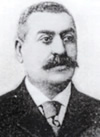Glossary (Levon, ruler of Cilicia – Matthew of Edessa)
Levon, ruler of Cilicia
Prince and ruler of Cilicia (1129-1141), sometimes called as Levon I, brother and successor of Thoros I. He retook the cities of Msis, Adana and Tarsus, previously captured by the leaders of the First Crusade. That ended the alliance with the Crusaders and soon brought Cilicia to anarchy. The Greek troops invaded Cilicia, captured a number of cities and arrested the members of Leon’s family. Forced to give himself up, he was chained and taken to Constantinople where he died in 1141.
Levon I
Prince, then King of Cilician Kingdom (1198-1219), sometimes called Levon II, or Levon the Magnificent. He reinstated the Armenian Kingdom after the fall of Ani. In alliance with the leaders of the 3-d Crusade, he waged successful wars against Saladin, the Sultans of Conium and the princes of Antioch. During his reign, he succeeded in establishing Cilician Armenia as a powerful and a prosperous state.
Levon III
King of Cilician Kingdom (1305-1308). Seeking support of the European powers, he sent messengers to the Pope Clement V. However, the Armenian embassy was given cold shoulder in Rome. The papal ultimatum to unconditionally submit the Armenian Church to Catholic caused mutiny in Cilicia. In 308, Leon IV was assassinated.
Levon IV
King of Cilician Kingdom (1320-1342). He was only 10 when succeeded to his father Oshin I. Invaded repeatedly by both the Mongols and Mamelukes, the Armenian Kingdom was on the verge of destruction. The truce, concluded later with Mamelukes, gave Armenians years of respite.
Levon V
Last King of Cilician Kingdom (1368-1375). His ascension coincided with the large-scale invasion of the Mamelukes. Leon V succeeded in concluding armistice, but the new aggression in 1371 forced him to surrender the most part of his Kingdom. In 374, the Mamelukes captured the rest of Cilicia and locked the Armenian King in inaccessible Kapan Fortress. He gave up after a desperate resistance and was exiled to Egypt. Leon V was released after John of Gaunt, King of Castile pleaded for him. He died in Paris in 1393.
Loris-Melikov, Mikhail
 Loris-Melikov
Loris-Melikov
(1825-1888) Russian statesman and military of Armenian origin, count. He was Minister of Interior under Alexander II.
Lusignan
Noble family from Poitou, France. During and after the Crusades, different branches of Lusignan princes ruled in Jerusalem, Cyprus, and Cilician Armenia.
Lesser Armenia
(Armenia Minor, Pokr Hayk) Historical designation of the territory to the West of the Greater Armenia including Cappadocia and Cilicia, and reaching Black Sea on the North.
Malatia
City in Turkey, west of the River Euphrates. In ancient times Malatia known as Melitine was center of the Third Armenia.
Mamikonyan
In ancient Armenia: dynasty of powerful Armenian princes. In the Arshakid period, the senior member of the Mamikonyan family traditionally held the post of Sparapet. By the 7-8-th centuries, the Mamikonyan princes gradually lost their leading role to other Armenian noble families.
Manandian, Hakop
 Hakop Manandyan
Hakop Manandyan
(1873-1952) Historian, member of Academy of Science of USSR and Armenian SSR. He authored some 100 monographs in Armenian, Russian and German.
Manazkert
(Manzikert) Ancient city of Armenia (now in Turkey). The old Armenian legend states that Manazkert was founded by Manaz, son of the forefather Hayk. In 1071, the Armenians inside the 100thousandth Byzantine army under Romanus IV Diogenes and the Seljuk Turks under Alp-Aslan met in battle. The Christian army was routed, and the Emperor was imprisoned. The battle of Manazkert had the most tragic consequences as the Turks took control over all of Armenia.
Mantashev, Alexander
 Alexander Mantashev
Alexander Mantashev
(Mantashian) One of the richest Armenian capitalists, founder of oil industry in Baku, industrialist and philanthropist.
Marash
(Germanike) City in Cilicia (now in southern Turkey). Marash was an important outpost of the Armenian Cilician Kingdom. Its transit location on the caravan routes between Ayas and Melitine predetermined its significance.
Mardakert
Region of today’s Nagorno-Karabakh Republic, approximately corresponding to the ancient Khachen Principality of Artsakh.
Martouni
Region of today’s Nagorno-Karabakh Republic, approximately corresponding to the Mius Aband and Varanda provinces of the ancient and medieval Artsakh.
Marzpan
In ancient Armenia: a governor of Armenia or an Armenian province appointed by the Persian kings. Later in medieval Armenia, marzpan was sometimes used as a symbolic honorary title.
Matthew of Edessa
Armenian historian of the 12-th century, author of a precious work describing the events in the Lesser Armenia from 952 to 1136. His Chronicle contains unique information on the history of relations of the Armenian rulers with the leaders of the Crusades.







